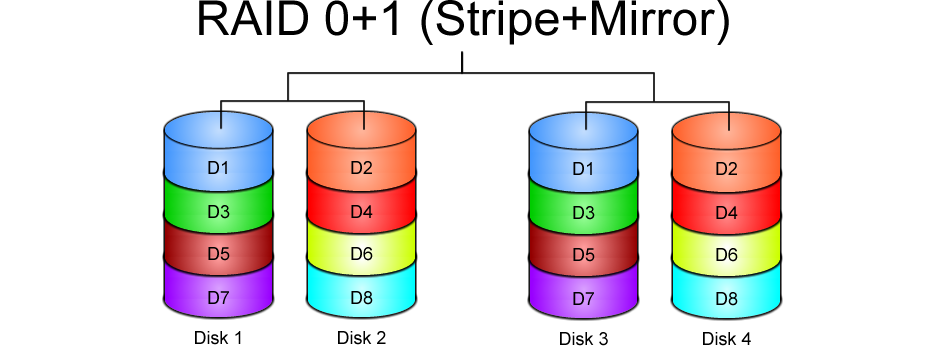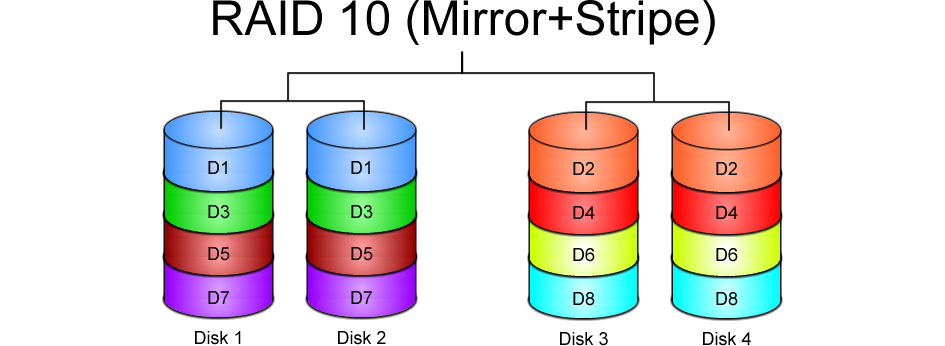RAID Defined
RAID stands for Redundant Array of Independent Disks. RAID is a method of combining several hard drives into one unit. It offers fault tolerance and higher throughput levels than a single hard drive or group of independent hard drives. RAID levels 0,1, 10 and 5 are the most popular.
The acronym RAID, originally coined at UC-Berkeley in 1987, stood for Redundant Array of Inexpensive Disks.
RAID Configurations
 | |
|---|---|
|
RAID 0 splits data across drives, resulting in higher data throughput. The performance of this configuration is extremely high, but a loss of any drive in the array will result in data loss. This level is commonly referred to asstriping. Minimum number of drives required: 2 Performance: High Redundancy: Low Efficiency: High |
Advantages:
Disadvantages:
|
 | |
|
RAID 1 writes all data to two or more drives for 100% redundancy: if either drive fails, no data is lost. Compared to a single drive, RAID 1 tends to be faster on reads, slower on writes. This is a good entry-level redundant configuration. However, since an entire drive is a duplicate, the cost per megabyte is high. This is commonly referred to as mirroring. Minimum number of drives required: 2 Performance: Average Redundancy: High Efficiency: Low |
Advantages:
Disadvantages:
|
 | |
|
RAID 5 stripes data at a block level across several drives, with parity equality distributed among the drives. The parity information allows recovery from the failure of any single drive. Write performance is rather quick, but because parity data must be skipped on each drive during reads, reads are slower. The low ratio of parity to data means low redundancy overhead. Minimum number of drives required: 3 Performance: Average Redundancy: High Efficiency: High |
Advantages:
Disadvantages:
|
 | |
|
RAID 6 is an upgrade from RAID 5: data is striped at a block level across several drives with double paritydistributed among the drives. As in RAID 5, parity information allows recovery from the failure of any single drive. The double parity gives RAID 6 additional redundancy at the cost of lower write performance (read performance is the same), and redundancy overhead remains low. Minimum number of drives required: 4 Performance: Average Redundancy: High Efficiency: High |
Advantages:
Disadvantages:
|
 | |
|
RAID 0+1 is a mirror (RAID 1) array whose segments are striped (RAID 0) arrays. This configuration combines the security of RAID 1 with an extra performance boost from the RAID 0 striping. Minimum number of drives required: 4 Performance: Very High Redundancy: High Efficiency: Low |
Advantages:
Disadvantages:
|
 | |
|
RAID 10 is a striped (RAID 0) array whose segments aremirrored (RAID 1). RAID 10 is a popular configuration for environments where high performance and security are required. In terms of performance it is similar to RAID 0+1. However, it has superior fault tolerance and rebuild performance. Minimum number of drives required: 4 Performance: Very High Redundancy: Very High Efficiency: Low |
Advantages:
Disadvantages:
|
 | |
|
RAID 50 combines RAID 5 parity and stripes it as in aRAID 0 configuration. Although high in cost and complexity, performance and fault tolerance are superior to RAID 5. Minimum number of drives required: 6 Performance: High Redundancy: High Efficiency: Average |
Advantages:
Disadvantages:
|
 | |
|
RAID 60 combines RAID 6 double parity and stripes it as in a RAID 0 configuration. Although high in cost and complexity, performance and fault tolerance are superior to RAID 6. Minimum number of drives required: 8 Performance: High Redundancy: High Efficiency: Average |
Advantages:
Disadvantages:
|
This guid was provided by https://www.icc-usa.com/raid-calculator/
